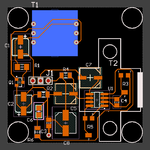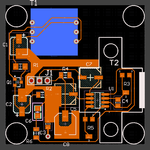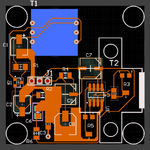inklen
Full Member level 1

Hey guys!
I've just started with electronics and I made this PCB for an amplifier which contains 2 transformers. Here's the layout (with some SMD components):

The transformers are on the opposite side.
This is my 2nd PCB and since this is an amplifier I wonder how the transformers affect the circuit (if it does at all). For example, look at the U1 IC which resides exactly under the transformer. Can this cause any problems? Reading the books, I think it's not going to affect anything as this is not an RF or UHF circuit. What do you think?
(the size of the PCB is 45x45 mm).
Thank you.
I've just started with electronics and I made this PCB for an amplifier which contains 2 transformers. Here's the layout (with some SMD components):

The transformers are on the opposite side.
This is my 2nd PCB and since this is an amplifier I wonder how the transformers affect the circuit (if it does at all). For example, look at the U1 IC which resides exactly under the transformer. Can this cause any problems? Reading the books, I think it's not going to affect anything as this is not an RF or UHF circuit. What do you think?
(the size of the PCB is 45x45 mm).
Thank you.
Last edited by a moderator:



